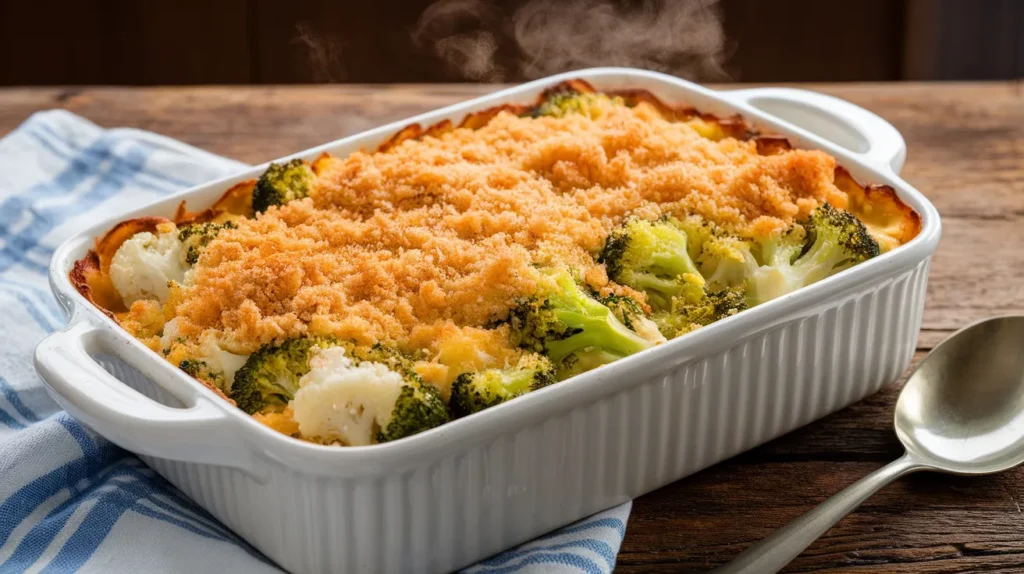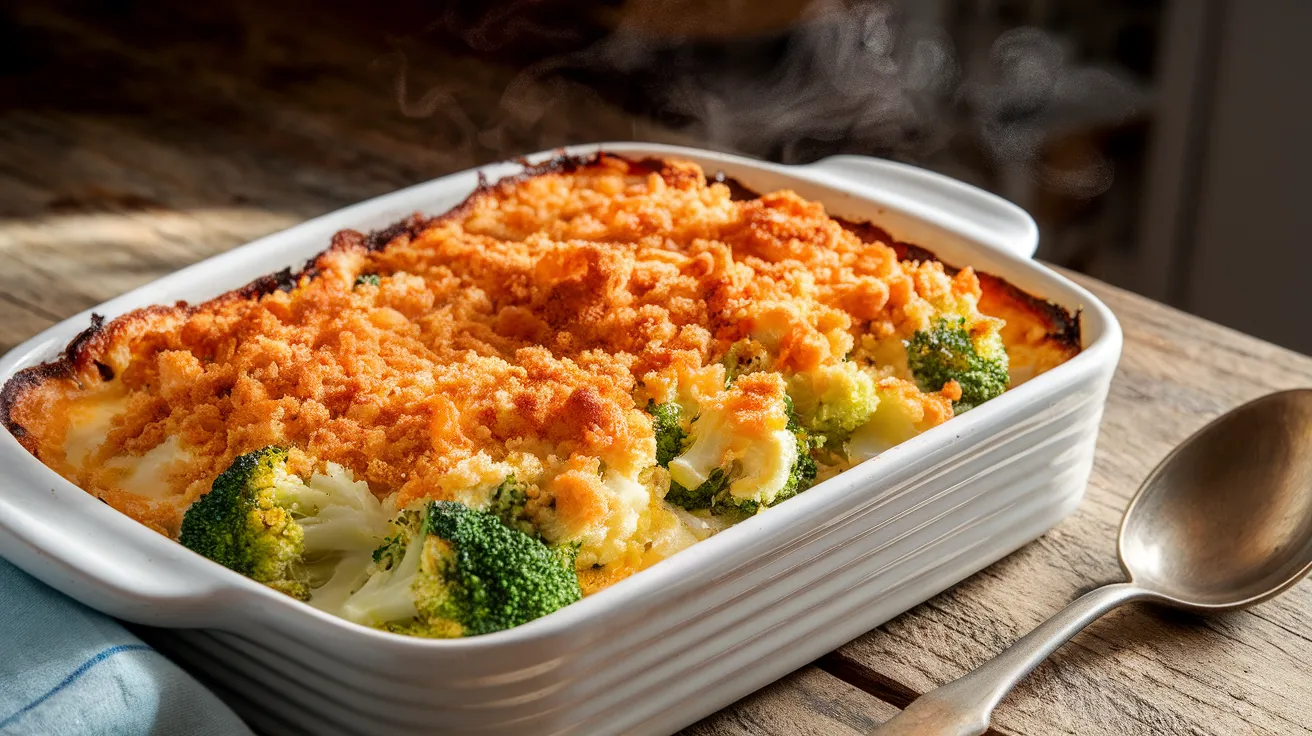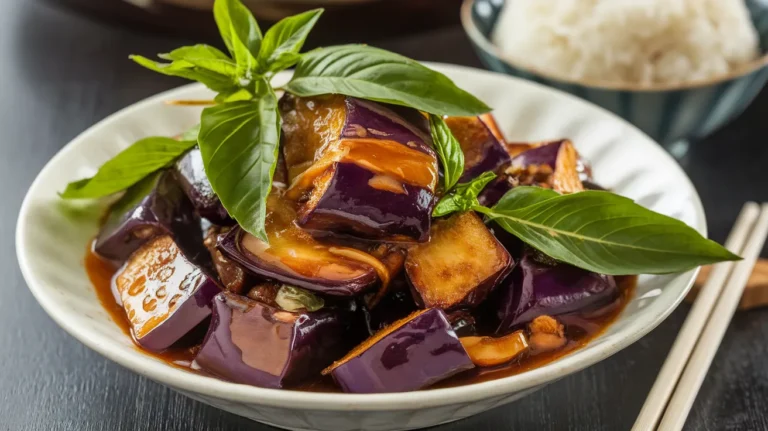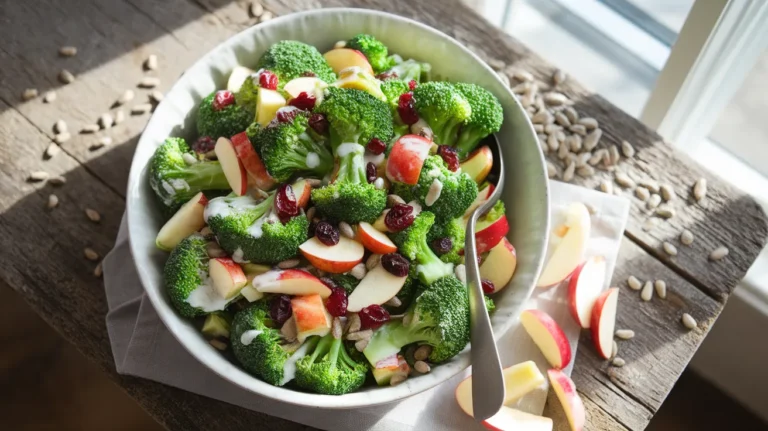This comforting broccoli cauliflower casserole combines tender vegetables with a rich, cheesy sauce that transforms simple ingredients into a crowd-pleasing side dish. Perfect for busy weeknights or holiday gatherings, this broccoli cauliflower casserole delivers maximum flavor with minimal effort, creating a golden-topped masterpiece that even picky eaters will love.
Recipe Info Bar
SERVES: 4 | PREP: 20 MIN | COOK: 35 MIN | TOTAL: 55 MIN
Ingredients
Fresh Vegetables
| Ingredient | Amount |
|---|---|
| Fresh broccoli florets | 3 cups |
| Fresh cauliflower florets | 3 cups |
| Yellow onion, diced | 1 medium |
| Garlic cloves, minced | 3 cloves |
Cheese Sauce Base
| Ingredient | Amount |
|---|---|
| Butter | 4 tablespoons |
| All-purpose flour | 4 tablespoons |
| Whole milk | 2 cups |
| Sharp cheddar cheese, shredded | 1½ cups |
| Parmesan cheese, grated | ½ cup |
Seasonings & Toppings
| Ingredient | Amount |
|---|---|
| Salt | 1 teaspoon |
| Black pepper | ½ teaspoon |
| Garlic powder | ½ teaspoon |
| Panko breadcrumbs | ¾ cup |
| Butter, melted | 2 tablespoons |
Step-by-Step Instructions
Phase 1: Prep Work (10 minutes)
Step 1: Preheat your oven to 375°F (190°C) and grease a 9×13-inch baking dish with butter or cooking spray. This prevents sticking and ensures easy serving later.
Step 2: Cut broccoli and cauliflower into uniform bite-sized florets, about 1-2 inches each. Consistent sizing ensures even cooking throughout your broccoli cauliflower casserole.
Step 3: Bring a large pot of salted water to a rolling boil over high heat. The salt seasons the vegetables from within, enhancing their natural flavors.
Phase 2: Blanching Vegetables (8 minutes)
Step 4: Add broccoli florets to the boiling water and cook for exactly 3 minutes. They should turn bright green but remain slightly firm – this is called blanching.
Step 5: Using a slotted spoon, quickly transfer blanched broccoli to a bowl of ice water to stop the cooking process. This technique preserves the vibrant color and crisp texture.
Step 6: Add cauliflower florets to the same boiling water and cook for 4 minutes until just tender when pierced with a fork. Cauliflower takes slightly longer than broccoli to cook properly.
Step 7: Transfer cauliflower to the ice water bath with the broccoli. Let both vegetables cool for 2 minutes, then drain thoroughly and pat completely dry with paper towels.
Phase 3: Creating the Cheese Sauce (12 minutes)
Step 8: In a large saucepan, melt 4 tablespoons of butter over medium heat. Watch carefully – the butter should bubble gently without turning brown, which would create a bitter flavor.
Step 9: Add diced onion to the melted butter and sauté for 3-4 minutes until translucent and softened. The onion adds depth and sweetness to your broccoli cauliflower casserole.
Step 10: Stir in minced garlic and cook for 30 seconds until fragrant. Be careful not to burn the garlic, as it can become bitter and overpower the dish.
Step 11: Whisk in flour and cook for 1-2 minutes, stirring constantly to create a roux. This mixture should form a paste-like consistency and smell slightly nutty – this eliminates the raw flour taste.
Step 12: Gradually pour in milk while whisking continuously to prevent lumps from forming. Start with just a splash, whisk until smooth, then slowly add the remaining milk in a steady stream.
Phase 4: Finishing the Sauce (8 minutes)
Step 13: Continue whisking and cook the sauce for 4-5 minutes until it thickens enough to coat the back of a spoon. The consistency should be similar to heavy cream.
Step 14: Remove from heat and immediately stir in shredded cheddar cheese, ½ cup at a time, until completely melted and smooth. Adding cheese gradually prevents it from clumping or separating.
Step 15: Whisk in grated Parmesan cheese, salt, pepper, and garlic powder. Taste and adjust seasoning as needed – the sauce should be well-seasoned since it flavors the entire casserole.
Phase 5: Assembly and Baking (35 minutes)
Step 16: Gently fold the blanched and dried broccoli and cauliflower into the cheese sauce until every piece is evenly coated. Mix carefully to avoid breaking the tender florets.
Step 17: Transfer the mixture to your prepared baking dish, spreading it evenly with a spatula. The surface should be relatively level for even browning.
Step 18: In a small bowl, combine panko breadcrumbs with 2 tablespoons melted butter, mixing until the crumbs are evenly coated. This creates the golden, crunchy topping.
Step 19: Sprinkle the buttered breadcrumbs evenly over the casserole surface. Don’t pack them down – loose crumbs create better texture.
Step 20: Bake for 25-30 minutes until the top is golden brown and the sauce is bubbling around the edges. The internal temperature should reach 165°F (74°C) for food safety.
Chef’s Notes
Texture Perfection: The key to an exceptional broccoli cauliflower casserole lies in not overcooking the vegetables during blanching. They’ll continue cooking in the oven, so keeping them slightly firm initially ensures they won’t become mushy.
Cheese Selection: Sharp cheddar provides the best flavor balance, but you can experiment with Gruyère or aged white cheddar for a more sophisticated taste profile in your broccoli cauliflower casserole.
Make-Ahead Magic: Assemble the entire casserole up to the breadcrumb stage, cover tightly, and refrigerate for up to 24 hours. Add breadcrumbs just before baking and increase cooking time by 5-10 minutes.
Sauce Consistency: If your cheese sauce seems too thick, whisk in milk one tablespoon at a time. If it’s too thin, simmer for an additional 2-3 minutes to reduce and thicken naturally.
Nutrition Box (Per Serving)
- Calories: 385
- Protein: 18g
- Carbohydrates: 22g
- Fat: 26g
- Fiber: 5g
- Sodium: 720mg
Creative Variations
Protein Power-Up: Transform this side into a main dish by adding diced ham or cooked chicken. Our broccoli ham cheese casserole offers another delicious protein-packed option.
Rice Addition: Layer cooked white or brown rice in the bottom of your baking dish before adding the vegetable mixture for a heartier broccoli cauliflower casserole that serves as a complete meal.
Mediterranean Twist: Replace half the cheddar with feta cheese and add sun-dried tomatoes, fresh herbs like oregano and basil, and a sprinkle of pine nuts for a Greek-inspired variation.
Grain-Free Option: Skip the flour and use cream cheese instead – melt 8 oz cream cheese into the milk for a naturally thick, keto-friendly sauce. You might also enjoy our broccoli cheese rice casserole for another comforting option.
Storage & Reheating
Refrigerator Storage: Cover leftover broccoli cauliflower casserole tightly with plastic wrap or aluminum foil and refrigerate for up to 4 days. The flavors actually improve after a day as they meld together.
Freezer Storage: Wrap individual portions in plastic wrap, then aluminum foil, and freeze for up to 3 months. Label with the date and contents for easy identification.
Reheating Instructions: For refrigerated leftovers, cover with foil and bake at 350°F for 15-20 minutes until heated through. For frozen portions, thaw overnight in the refrigerator, then reheat as directed above.
Microwave Method: Individual portions reheat well in the microwave – use 50% power for 2-3 minutes, stirring halfway through to ensure even heating.

Troubleshooting Guide
Problem: Watery Casserole Solution: This happens when vegetables aren’t dried properly after blanching. Always pat vegetables completely dry with paper towels and let them sit for a few minutes to release excess moisture before mixing with the sauce.
Problem: Lumpy Cheese Sauce Solution: Remove the pan from heat completely before adding cheese, and add it gradually while stirring constantly. If lumps form, whisk vigorously or use an immersion blender to smooth the sauce.
Problem: Burnt Breadcrumb Topping Solution: Cover the casserole with foil halfway through baking if the top browns too quickly. Next time, place the baking dish on the middle oven rack rather than the top rack.
Problem: Bland Flavor Solution: The vegetables and sauce need adequate seasoning. Taste the cheese sauce before assembling and adjust salt, pepper, and garlic powder. Remember that cheese provides saltiness, so balance accordingly.
Problem: Mushy Vegetables Solution: Reduce blanching time by 1 minute for each vegetable next time. The broccoli cauliflower casserole continues cooking in the oven, so vegetables should be slightly underdone initially.
Equipment Essentials
- Large pot (for blanching vegetables)
- 9×13-inch baking dish
- Large saucepan (for cheese sauce)
- Wire whisk
- Slotted spoon
- Large mixing bowl
- Measuring cups and spoons
- Sharp knife and cutting board
Shopping List
Produce Section
- Fresh broccoli (1 large head)
- Fresh cauliflower (1 medium head)
- Yellow onion (1 medium)
- Fresh garlic (1 bulb)
Dairy Section
- Butter (1 stick)
- Whole milk (16 oz container)
- Sharp cheddar cheese (8 oz block for shredding)
- Parmesan cheese (container of grated)
Pantry/Dry Goods
- All-purpose flour
- Panko breadcrumbs
- Salt
- Black pepper
- Garlic powder
Success Secrets
1. Always blanch vegetables in heavily salted water – it should taste like seawater. This seasons the vegetables from the inside out, creating more flavorful results in your finished broccoli cauliflower casserole.
2. Use freshly grated cheese whenever possible instead of pre-shredded varieties. Fresh cheese melts more smoothly and creates a creamier sauce because it lacks anti-caking agents.
3. Let the assembled casserole rest for 5 minutes after removing from the oven before serving. This allows the sauce to set slightly, making it easier to serve neat portions.
4. Test for doneness by inserting a knife into the center – it should come out hot to the touch and the edges should be bubbling vigorously around the perimeter.
5. Double the recipe easily for larger crowds by using a disposable aluminum pan – perfect for potlucks where you don’t want to worry about getting your dish back.




